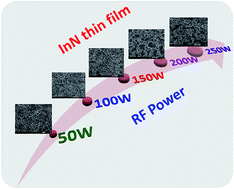Investigation of the electrochemical behavior of indium nitride thin films by plasma-assisted reactive evaporation
Abstract
Indium nitride (InN) thin films were deposited on Si (111) substrate by plasma-assisted reactive evaporation with a variable radio frequency (RF) power supply. The effects of RF power on the structural, morphological, and optical properties of the films were investigated by X-ray diffraction analysis, scanning electron microscopy, energy-dispersive X-ray analysis, UV-vis transmittance, and micro Raman spectroscopy. The electrochemical behaviors of the InN thin films were investigated in 0.1 M KOH electrolyte towards electrochemical water splitting. Linear sweep voltammograms revealed that the anodic current decreases by increasing RF power for the growth of InN thin films. The charge transfer dynamics between the InN thin film and electrolyte interfaces during the electrochemical process were studied using electrochemical impedance spectroscopy (EIS). Variations in donor density and flat band potentials of the InN thin films were deduced from Mott–Schottky plots. Further, the electrocatalytic behavior of InN thin films was investigated with a K3[Fe(CN)6] redox probe. The good electrochemical behavior of InN thin films showed that this material could be a potential candidate for water splitting application.


 Please wait while we load your content...
Please wait while we load your content...